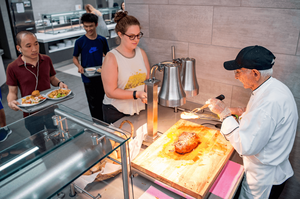 "
"
Picture this: you’re walking across the quad, ready to quench your thirst, satiate your hunger, eager to put that never-ending calculus class behind you. The scent of warm pastries begins to envelop you. The spices whirl their way in, and the sound of the saute pans sizzling sends your taste buds into a frenzy. ID swiped, stomach growling. Instead of relief upon entry to the dining hall, however, you’re hit with a new source of stress: anaconda-like lines sweeping around the pillars and beyond. What a terrible, ill-timed game of hungry, hungry hippos!
In the face of COVID-19, dining hall staff had to adopt new strategies to ensure the safety of both students and employees. This entailed take-out, bringing your own cutlery and — instead of the traditional serve-your-self system — employees doled out servings to students. This assembly-line-style order process enabled students to walk in and out of the dining hall in a matter of minutes.
With the recent high vaccination rates and campus life back in full swing, the dynamics within the dining halls changed once again. Students have seen a wider variety of food options, such as stir fry, a hamburger station and a taco bar. The plexiglass barriers have come down and the dining halls are operating at full capacity. Employees push carts of plates across the dining hall and clean up self-serve areas in efforts to restock and keep up with the bustling crowds.
Both North and South Dining Hall staff are working diligently around the clock. Nevertheless, the question on students’ minds is, “Why are these lines taking forever?” Director of Campus Dining Luis Alberganti provided some color on the issues the team is currently facing.
“Building your own meal requires a compromise,” Alberganti explained. Students have been given a greater variety of options as opposed to last year’s limited dishes served by staff who determined the portions for students. The luxury of choosing what to have for breakfast, lunch and dinner requires time and thought, which slow down the process. Alberganti also revealed that there has been difficulty in employing staff. “There is a crisis. We have a crisis,” he said. “The pool of culinary workers is hollow. There are just less workers available.”
In an effort to employ staff for the dining halls, Alberganti explained that Campus Dining has increased their advertising budget in order to reach a wider audience of possible workers in the South Bend area. Among those in the target audience are high school students who, when employed, will be offered flexible schedules and hours. By signing into LinkedIn, or other sites like Getwork, one can see a number of positions available. These options are also made available on the university’s dining hall website. The director also added that they have raised starting wages as a means of attracting workers since previous employees have left to pursue other interests.
Along with a labor shortage, many students have also noticed a food shortage. Some students have pointed out that certain beverages, such as orange juice and chocolate milk, are often unavailable. These dispensers bear a sign that states the products’ unavailability, which leads to frustration for many. Like the labor shortage issue, there are bigger forces at play with the food supply chain.
“There is a national crisis. Food manufacturers are not immune to the pandemic,” Alberganti said. As COVID-19 persists, the country continues to face health and economic issues. Among these are food sector instability and difficulties with distribution. Prior to the pandemic, 35 million people in America faced food insecurity, and the issue has since only worsened. During last year’s pandemic peak, businesses and restaurants shut down, people waited in long lines to receive food and families stocked up on supplies. As a result, the previously operational food industry experienced significant disruptions it has yet to overcome. Farmers have struggled to hire sufficient workers and food distributors have seen a change in the supply chain that, as Alberganti points out, “often warrants the cancelation of orders.” This can help to explain the lack of certain beverages on campus.
Only time will be a marker of change in terms of restoring order in the supply chain. Alberganti speculates that it will take a month before the dining hall operates swiftly and efficiently once more. While the nation is struggling to go back to a post-COVID-19 world — and fighting the rising infection rates as a result of the delta variant — there are efforts being made right here on campus to secure the well-being of staff and students.
“We try not to overwork our employees,” Alberganti said. “With football weekends around the corner, we are doing our best to hire.” Assuredly, football weekends entail extravagant food options, as well as packed dining halls. With a limited staff, patience is key. Sarah, a dining hall worker, shared her perspective as an employee. “Sometimes I feel the pressure. There are days I do feel it and days I don’t,” she said. “For the most part, it seems like students are understanding.” Students can see employees hustling in and out of the kitchen and moving empty dishes out of the way for students to swiftly access food.
Thus far, the day’s homestyle meals, especially the pastries, continue to call floods of students forward, making lines long but worthwhile. Luis Alberganti leaves students with a parting offer. For students interested in on-campus employment, Alberganti assures that interviews are happening and urges any and all students to consider Campus Dining as an employer.
“Apply today!” He exclaimed. “We are hiring on the spot.”